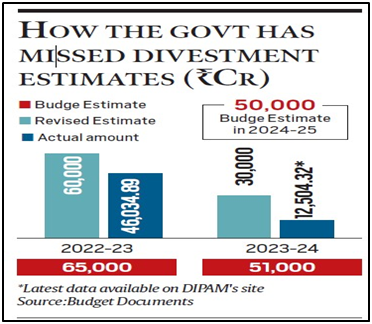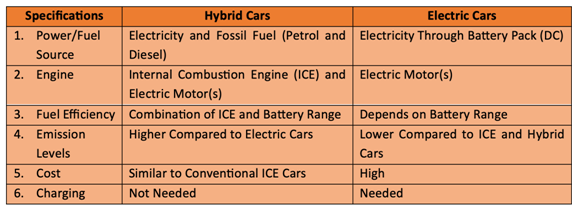Why in News?
- With the ‘mantra’ of ‘Sabka Saath, Sabka Vikas, and Sabka Vishwas’ and the whole of nation approach of “Sabka Prayas”, the Union Minister for Finance presented the Interim Union Budget 2024-25 in Parliament.
- Here we will try to analyse different aspects of the interim union budget 2024-25.
What’s in Today’s Article?
- Tax buoyancy helps Centre Align with its Fiscal Consolidation Roadmap
- Tax Resolution Scheme to Benefit over One Crore
- Centre to Follow a ‘Calibrated’ Approach to Divestments in FY25
- Rooftop Solar Scheme – Households to get 300 Units Free Power
- Rs 1 Lakh Crore Corpus to Incentivise R&D in Private Sector
Tax buoyancy helps Centre Align with its Fiscal Consolidation Roadmap:
- The government’s aim:To restrict the fiscal deficit to 5.8% of the GDP as against 5.9% budgeted earlier for the financial year and to restrict the fiscal deficit target to below 4.5% by 2025-26.
- How? By riding on the back of a strong buoyancy in tax revenues. Tax buoyancy is defined as the ratio of change in taxes to GDP. Higher tax buoyancy suggests that tax revenue would increase at a quicker rate than income growth.
- Direct tax revenue:
- Direct tax revenues are estimated to grow 17.2% year-on-year to Rs 19.45 lakh crore in the current financial year 2023-24.
- For the next financial year, direct tax collections, which include income tax and corporate tax, are estimated to rise 13.1% to Rs 21.99 lakh crore.
- On the indirect taxes side:
- Central Goods and Services Tax (CGST) collections are estimated to grow 13% to Rs 9.18 lakh crore in 2024-25.
- Overall, the indirect tax collections, which include customs, excise duties and GST (including compensation cess), are expected to yield Rs 16.22 lakh crore to the government in 2024-25.
- What does this indicate?
- The growth rate for tax revenues estimated for 2024-25 at nearly 12% (net) is much higher than the 10.5% nominal GDP growth assumed for Budget arithmetic for 2024-25.
- The strong growth in tax revenues reflects the high tax buoyancy, which works out to be 1.2 for FY 2023-24 as against 1.0 in FY23. For 2024-25, the tax buoyancy is seen at 1.1.
- These revenue estimates can take care of any unforeseen expenditure or slippage in disinvestments in FY25.
Tax Resolution Scheme to Benefit over One Crore:
- In a relief to tax-payers grappling with outstanding tax demands, the Finance Minister announced a resolution for “disputed direct tax demand” dating back to 1962, the year of enactment of the Income-Tax Act.
- Under this, the government has decided to withdraw outstanding direct tax demands up to Rs 25,000 for the period up to financial year 2009-10 and up to Rs 10,000 for financial years 2010-11 to 2014-15.
Centre to Follow a ‘Calibrated’ Approach to Divestments in FY25:

- The calibrated approach: The government has estimated it will get Rs 50,000 crore in 2024-25 in the form of ‘miscellaneous capital receipts’ without mentioning the word disinvestment.
- Need for a calibrated approach:
- The government is taking care of the (governance, development and performance) with respect to CPSEs.
- If we look at CPSEs’ performance – whether it comes to capex of Rs 3.2 lakh crore, their growth story, their investments in green energy, their performance on return on capital employed and equity – they are big market players.
- They will continue to improve and reward shareholders including the government.
- Future plans: Strategic sale of CPSEslike BEML, SCI, HLL Life Care, NMDC Steel, and IDBI Bank is expected to be completed in the current financial year, although analysts believe it could come to fruition only after the General Elections later this year.
Rooftop Solar Scheme – Households to get 300 Units Free Power:
- The Pradhan-mantri Suryodaya Yojana (announced by the PM on January 22):
- People availing the newly-announced rooftop solar scheme will be entitled to 300 units of free electricity every month.
- This will help them save up to Rs 18,000 annually by getting free solar electricity and by selling the surplus power to the distribution companies.
- The PM announced that rooftop solar systems would be installed in “one crore houses”, without specifying a timeframe for the target to be achieved.
- The Finance Minister said the scheme would also help the adoption of electric vehicles (EVs) by providing charging stations at home.
- The scheme was also expected to result in entrepreneurship and employment opportunities in supplies, installation and maintenance.
- Need for the new scheme:
- The new scheme adds on to an ongoing rooftop solarisation programme running for at least a decade now.
- About 40% or 40 gigawatts (GW) of the government’s initial target of setting up 100 GW of solar capacity by 2022 was meant to be through rooftop systems.
- However, by 2023 end, the country’s total solar capacity stood at 73.3 GW, of which grid-connected rooftop systems comprised only about 11 GW or 15%.
Rs 1 Lakh Crore Corpus to Incentivise R&D in Private Sector:
- In a significant initiative to incentivise R&D in the private sector, the Finance Minister announced the establishment of a financial corpus of Rs 1 lakh crore that will provide low-cost or zero-interest loans for research and innovation.
- The private companies could avail of interest-free loans for up to 50 years (long-term financing or refinancing facility) through this new mechanism.
- This will encourage the private sector to scale up research and innovation significantly in sunrise domains.
- The new fund is in sync with the government efforts to encourage private sector involvement in research activities.
- Last year, it had set up a National Research Foundation (NRF) whose main objective is to significantly improve, both in qualitative and quantitative terms, the country’s research output.
- The NRF earmarks a spending of Rs 50,000 crore on research activities over the next five years.
- More than 70% of this money is envisaged to come from the private sector.

